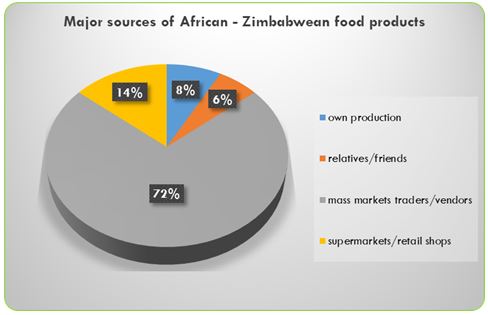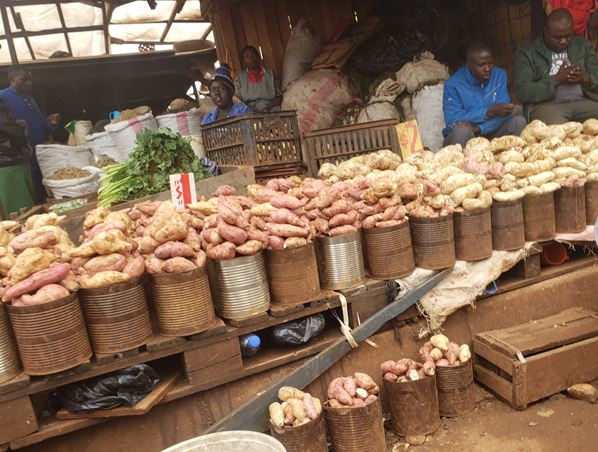|
Getting your Trinity Audio player ready…
|
By Charles Dhewa
Answering the above question is at the centre of a campaign being implemented by the Alliance for Food Sovereignty in Africa (AFSA) in more than 13 African countries including Zimbabwe. Dubbed My Food is Africa, the campaign started in 2022 with baseline surveys to understand local people’s perceptions of African food. In Zimbabwe, insights were gathered from more than 60 households of Harare, formal institutions like boarding schools, hospitals, and universities, among other sources.
The role of different actors in advancing or undermining African food
Figure 1: Major sources of African-Zimbabwean food products

- 72% of the respondents get their African-Zimbabwean food products from mass markets like Mbare, Lusaka in Highfield and PaDust in Haticliffe.
- 14% of the respondents buy African-Zimbabwean food products from supermarkets/retail shops, especially those from low density suburbs and those working in the Central Business District. Some of these households indicated they would have preferred buying from Mbare because of wider diversity and relatively cheaper commodities but they were pressed on time and distance to visit the market.
- 8% of own production is mainly the indigenous chicken by middle density suburb households like Waterfalls where they say have bigger spaces for fowl runs.
- Relatives and friends (6%) also play a part in distributing African-Zimbabwean food products especially as they travel to urban areas from their rural homes, they bring with them such food products and share with relatives and friends.
Role of food vendors and caterers
- Increasing demand for traditional food over the years. Some customers especially men who eat traditional meals at these places claim their wives have no knowledge on how to cook while some complain about the long time it takes to cook traditional food, which also has a bearing on cost of power.
- Business is at peak during weekends, month end, public holidays and festive seasons. Major customers are sports fans, people from after social events/parties like weddings, graduations; social clubs especially soccer (maboozer); micro, small and medium entrepreneurs operating at these centres and their employees. Some formally employed consumers drive from their work places to these centres for lunch.
- The growing food vending sector is also following the increasing trend of the micro, Small and medium Enterprise (MSME) sector. Food vendors have become part of this sector’s ecosystem providing food to traders of food and non-food items in different locations of towns, cities and growth points.
- Residential food vendor businesses are for decades considered informal and illegal hence they lack: proper and formally designated work space and amenities, appropriate cooking facilities and as result some potential customers shun to eat their food or do business with them.
Role of restaurants
- Transitioning of some restaurants to traditional food has been informed by recent consumer trends where demand seems to be shifting towards traditional meals.
- Rather than preparing meals that wait for consumers, some restaurants prefer working more with orders although there tends to be walk-in consumers especially during lunch time and weekends.
- Meal prices range from USD2 to USD15 depending with meal composition and restaurant. Some customers feel the prices are too high and exclusive of the majority potential customers. As a result, some customers go to the restaurant when they are invited to an event or a better to do friends.
- What is also emerging is that when you are developing a market for indigenous food it is not easy to forecast consumption volumes and patterns in terms of how many plates of small grains meal per day since loyal customers will not be easy to determine. It will be more like cautiously shooting in the dark and trying to work with orders in terms of number of plates requested by formal institutions.
Fast food outlets
- Demand for fast food products is on the increase than ever before despite some complaining of harsh economic conditions and high unemployment.
- No traditional menus are prepared and served in these outlets.
- Top on the menu include chicken – broilers and fried chips.
Hotels and Lodges
- Menus try to respond to the needs of diverse customers. However, most people who stay at the hotel often consume whatever is available without asking too many questions except those with medical conditions that require them to consume specific meals including vegetarians. This shows the extent to which most consumers trust the Chef’s decision and judgement. It means Chefs have enormous power to influence what consumers can eat.
- Some foreign visitors prefer food types they know and consume in their home countries while very few want to experiment with new food.
- One big hotel has set aside a day for traditional menus where consumers are saved local food including wild animal meat. However, some traditional food items like mopane worms (madora/mancimbi) and roasted are becoming part of daily meals.
- Food procurement is through the buyers who adhere to a suppliers’ list and do not accept walk-in suppliers.
Role of hospitals
- Menus are designed in close consultation with dieticians and medical doctors who prescribe what different patience should consume according to medical conditions. However, there are standard meals consumed by all patients including pregnant mothers. These comprise sadza, meat and vegetable.
- In some health institutions, traditional food menus are served twice or thrice per week and these include finger millet mainly for porridge and sadza. There is still less interest in pearl millet and sorghum. All types of dried & fresh indigenous vegetables, beef, sugar beans and indigenous chicken are served as relish.
- Demand for traditional meals and organically produced commodities is increasing especially in private hospitals where individual patients’ needs attention is more pronounced.
- In line with regulations by the Procurement Regulatory Authority of Zimbabwe (PRAZ), food is procured through registered organizations which also have to provide tax clearance. Chefs are also responsible for quality control to make sure the food procured meets health standards.
Role of higher tertiary institutions
- Meals are mostly standard comprising sadza or rice with beef or chicken including additives like tomatoes, onion and leafy vegetables.
- At University of Zimbabwe African traditional food is only served at commercial canteens with the price ranging from USD4 to USD7 per plate depending on composition but this is far beyond reach of the majority of students. Such food include finger millet sadza, indigenous rice, all kinds of dried indigenous vegetables (mufushwa); boiled roundnuts & cowpeas (mutakura), sweet potatoes and mopane worms (madora). Menus are reviewed from time to time and sometimes test runs for new meals are conducted.
- Sometimes the university is requested by big organizations like the UN to prepare food for events like World Mental Health Day. In some cases, the UZ prepares traditional food with an African theme.
- Procurement of food needs approval from the Procurement Regulatory Authority of Zimbabwe (PRAZ) which currently insists that tertiary institutions should buy food or any commodities from PRAZ-registered companies or organizations.
- To supplement its food purchases, UZ grows and supply maize and fresh vegetables, onion, broccoli, cauliflower and others from its university farm which is often given production plans.
- Both UZ and HIT confirmed that preference for traditional meals has been increasing over the past few years as health consciousness increases among staff, ordinary people and students. This is buttressed by a recent study conducted by researchers at Chinhoyi University of Technology (CUT) which revealed growing appreciation for traditional food by the mature aged academics who see traditional food as a reference point for their indigenous cultural identity.
Boarding schools are more of the first home for learners as they spend much more time at school than at home during their learning years. The survey covered three boarding schools to assess their meals and consumption patterns and below are the findings:
- Some boarding schools are private and their food preferences for the pupils are dictated by family wealth.
- Menus are designed based on the five nutrients including carbohydrates, proteins, vitamins and others.
- Food is bought from formal supermarkets, schools own farms and sometimes mass markets like Mbare in Harare and Sakubva in Mutare.
- Based on their food knowledge, the Chefs try to balance starch with protein. However, they have discovered that most children do not like leafy vegetables and this goes back to how they were raised at home as well as the current meals being consumed at their homes. One of the main reasons why children do not like vegetables is because of the taste. For young people taste is a key determinant of consumption.
- The Chefs have had to improvise by combining different foods in order to enhance taste by for instance making a paste vegetable menu which children will not be able to separate into different components since it will be a wholesome meal.
- One school has introduced traditional Wednesday for promoting traditional food. While the children do not even like white sadza, they have embraced rice as their staple, not bread. This implies the nation should be promoting rice production in place of wheat production.
- May be more days should be set aside for traditional meals rather than one day per week.
- Food and Nutrition is studied as a subject but practicing what is learned is a challenge.
- Some menus are sports-oriented, being either carbohydrates or protein based, depending on the type of sport.
Across Africa, many organizations and stakeholders are already doing some work on African food and such work just need to be consolidated and documented. Promotion and consumption processes are already happening through relationships and silent channels. The campaign may consider learning from the way Africans promote their food systems which may be different from what happens in other parts of the world.
AUTHOR’S CONTACT DETAILS:
info@knowledgetransafrica.com
Website: www.emkambo.co.zw / www.knowledgetransafrica.com
Mobile: 0772 137 717/ 0774 430 309/ 0712 737 430
